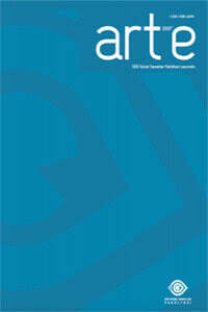GÖRSEL ALGI KURAMLARINA GÖRE REKLAM İÇERİKLİ TASARIMLARIN DEĞERLENDİRİLMESİ1
Bu çalışmanın amacı reklam içerikli tasarımların görsel algı kuramlarına göre değerlendirilmesidir. Bu amaç çerçevesinde tasarımların değerlendirilmesine ilişkin ölçütler alanyazına ve uzman görüşlerine göre belirlenerek değerlendirme sürecine geçilmiştir. Tasarımlar Gestalt Algı Kuramı, Olasılıklı Öğreti Kuramı, Nörofizyolojik Yaklaşım, Doğrudan Algı Kuramı, Yapılandırmacı Görsel Algı Kuramı, Bilişimsel Algı Kuramı olarak belirlenen görsel algı kuramlarına göre değerlendirilmiştir. Araştırma iki aşamadan oluşmaktadır. Birinci aşamada reklam içerikli tasarımlar doküman analizine dayalı olarak araştırmacı tarafından algı kuramları ile ilişkili olarak belirlenen tasarım ölçütleri çerçevesinde belirlenmiştir. Araştırmanın ikinci aşamasında ise afiş, billboard, dış mekan tasarımı vb. tasarımlar göstergebilim analizinin görsel algı kuramlarına dayalı olarak işe koşulması ile değerlendirilmiştir.
EVALUATION OF ADVERTISEMENT DESIGN BASED ON VISUAL PERCEPTION THEORIES
The purpose of this study was to evaluate the advertisement designs from the perspective of visual perception theories. For this purpose, design criteria of visual perception theory was developed based on the literature and expert opinions. Visual perception theories such as Gestalt Theory, Brunswick's Probabilistic Functionalism, Neuropsychological Theory, Theory of Direct Perception, Constructivist Visual Perception Theory and Computational Approach to Visual Perception provided for the evaluation of advertisement based designs. The research designed based on two steps. Firstly advertisements were determined through the document analysis including visual perception theories design principles. At the second step the advertisements such as posters, billboards, outdoor designs and etc. were evaluated through semiotic analysis.
___
- Behrens, R., (1984). Design In The Visual Arts, Englewood Cliffs, NJ: Prentice-Hall.
- Brunswick, E., (1950). "The Conceptual Framework Of Psychology", International Encyclopedia of Unified Science, (Ed.) O. Neurath 1(10), 16-33.
- Creswell, J. W., (2007). Qualitative Inquiry And Research Design: Choosing Among Five Approaches, Sage Publications: California.
- Eidenberger, H., (2004). A New Perspective On Visual Information Retrieval, http://www.ims.tuwien.ac.at/media/documents/publications/ei2004-vir.pdf (Erişim tarihi: 12.05.2014).
- Erişti, S. D., vd., (2010a). "An Evaluation Of Instructional Website Designs From The Perspective Of Visual Perception Theories: A Study On Scale Development", Contemporary Educational Technology,(1)4.
- Erişti, S. D. vd., (2010b). An evaluation of educational Web-sites from the perspective of perception-oriented design principles, International Journal of Instructional Technology and Distance Learning, (7)10.
- Gibson, J., (1986). The Ecological Approach To Visual Perception, Psychology Press, New York.
- Greenbaum, Thomas L., (1998). The Handbook For Focus Group Research, Second Edition, Sage, Thousand Oaks.
- Gregory, R. L. vd., (1995). The Artful Eye, Oxford University Press, England.
- Gordon, I.E., (2004). Theories Of Visual Perception, Psychology Press, New York.
- Hoeft, F. vd., (2007). "Prediction Of Children's Reading Skills Using Behavioral", Functional And Structural Neuroimaging Measures, Behavioral Neuroscience, 121(3), 602-613. Marr, D (1982). Vision. San Francisco, CA: Freeman & Co.
- Naglieri, J. A., & Das, J. P., (1997). Cognitive Assesment System, Austin, TX: Pro-Ed.
- Smeulders, A.W.M. ve diğerleri, (2000). "Content-Based İmage Retrieval At The End Of The Early Years", IEEE Transactions On Pattern Analysis And Machine Intelligence, 22(12), 1349- 1380. Smeulders, Worring ve diğ., 2000.
- Van Leewen, T., (2005). Introducing Social Semiotics, London, England: Routledge. Yıldırım, A., & Şimşek, H., (2013). Sosyal Bilimlerde Nitel Araştırma Yöntemleri, 9. Baskı, Seçkin Yayıncılık, Ankara.
- Yayın Aralığı: Yılda 2 Sayı
- Başlangıç: 2008
- Yayıncı: Süleyman Demirel Üniversitesi Güzel Sanatlar Fakültesi
Sayıdaki Diğer Makaleler
Erken Yaş Gitar Eğitimiyle İlgili Basılı Öğretim Materyallerinin Karşılaştırmalı Analizi
BURDUR İLİ GELENEKSEL MEKİKLİ DOKUMALARI1
Tasarımda Süsleme Malzemesi Olarak İpekböceği Kozasının Kullanımı: Hatay Örneği
Nuran KAYABAŞI, Ayşegül KARAKELLE, Feryal SÖYLEMEZOĞLU
Eskişehir Arkeoloji Müzesi'nde Bulunan Afyon Yöresi Kilimlerinden Örnekler
GÖRSEL ALGI KURAMLARINA GÖRE REKLAM İÇERİKLİ TASARIMLARIN DEĞERLENDİRİLMESİ1
Görkem URGUN, Suzan Duygu ERİŞTİ BEDİR
BİR OYUNCULUK TEKNİĞİ OLARAK TRANSFER1
Burdur İli Geleneksel Mekikli Dokumaları
Naile Rengin OYMAN, Kevser HIZ
Bir Oyunculuk Tekniği Olarak Transfer
GELENEKSEL TÜRK GİYİM KÜLTÜRÜ ve 20. YÜZYIL MODASININ KESİŞME NOKTASI: GEOMETRİK KESİM1
